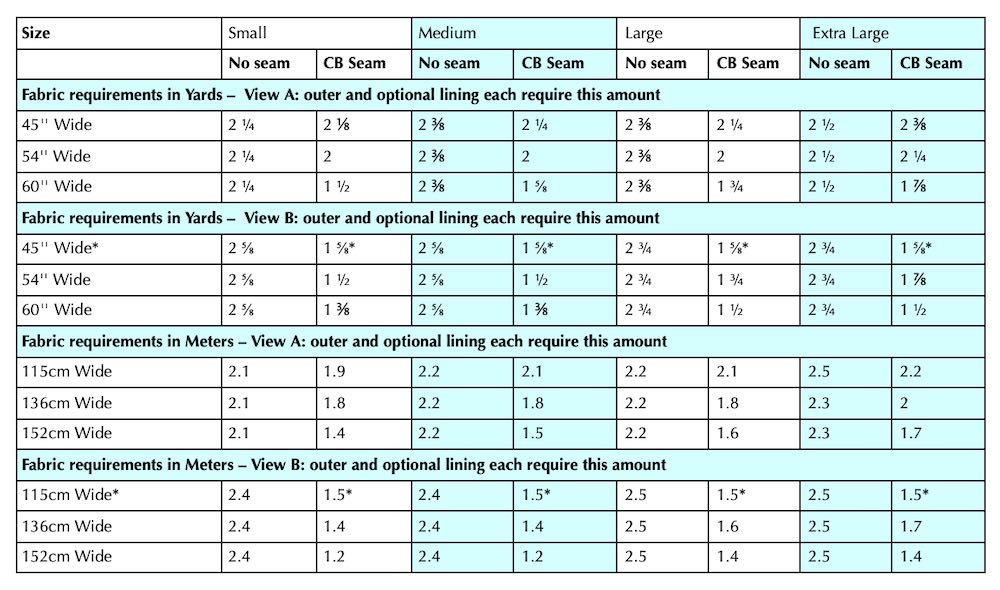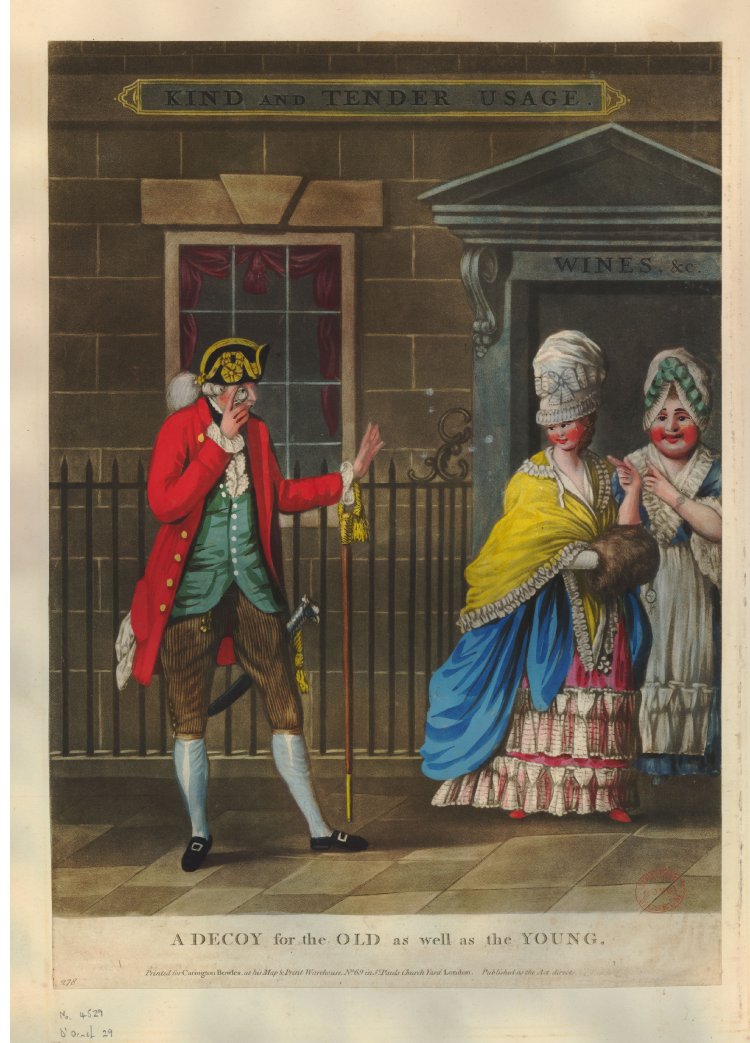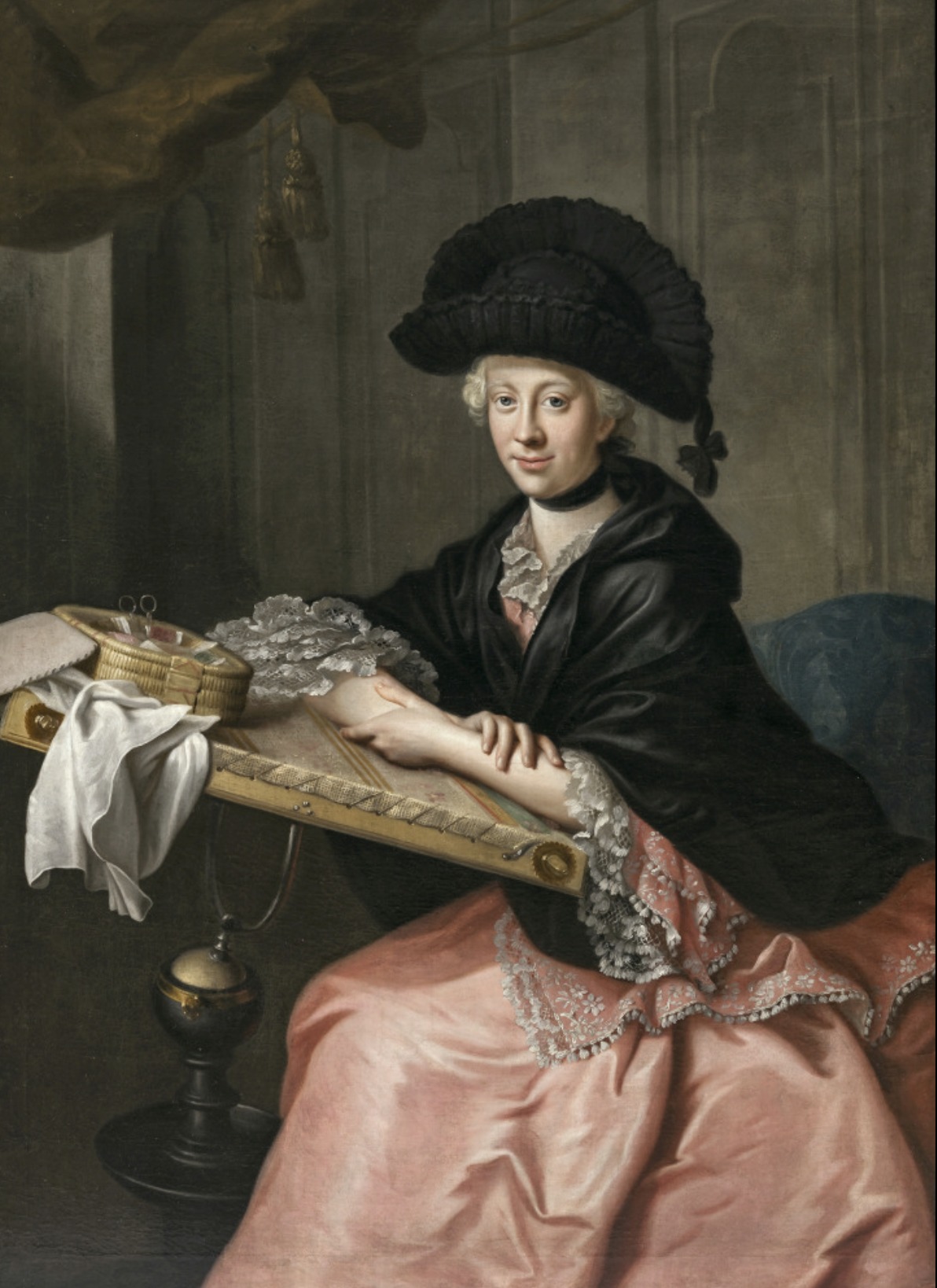The mini-collection of Scroop + Virgil’s Fine Goods mantle patterns are due to launch the first week of December, and we’re SO excited about them!
Apparently you’re so excited too, because we’ve been receiving messages asking about the fabric requirements for the upcoming patterns, so you can shop the Black Friday sales for your fabric and get sewing as soon as the pattern launches.
As always, happy to help! Here are the suggested fabrics and requirements for each pattern, so you can start shopping and dreaming 💛
Sizing:
All three patterns will be available in four sizes which cover the full Scroop + Virgil’s Size Range of 30”/76cm bust to 52”/115cm bust. Because mantle patterns are so adaptable, the patterns will easily fit larger and smaller sizes as well.

The Patterns:
The Marie Mantle: 1740-1779
The Marie is an unlined short mantle with two body views and an optional small hood. The pattern includes instructions on self-fabric trim variations, as well as instructions on making it in lace or gauze in addition to standard fabrics like light-midweight silks.
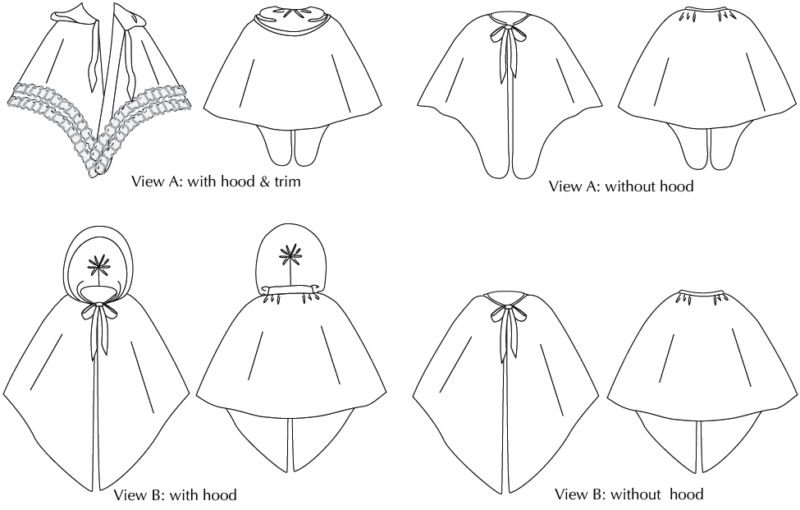
Recommended Fabrics:
Light-midweight silks including silk satin, silk taffeta, and silk lustring/lutestring. Lightweight cottons including muslin and voile. Gauze weaves, lace, and net in silk and cotton.
Consult period images and extant mantles for examples of accurate fabrics and colours.
IMPORTANT: The fabric requirements include the amount needed for cloaks cut in one piece with no centre back seam and the grainline running along the width of the mantle, and mantle cut with a centre back seam and the grainline running up and down the mantle. Directional fabrics should be cut with a centre back seam, or otherwise pieced.
Mantles with hoods and without hoods require the same amount of fabric.
Notions:
- 1½y/1.3m long x ½”/1.2cm-2”/5cm wide silk ribbon for the neck ties
- 100/2 linen or silk hand-sewing thread
- Hoodless mantles: ⅝y/.5m ¼”/3mm wide cotton or linen tape to reinforce the neck
- Lace Edging for Fabric Mantles, hem, front edge, and hood edge trimmed with lace:
- View A: 5⅛y/4.7m long x ¾”-2”/2cm-5cm wide lace trim with one straight edge and one scalloped
- View B: 5¾ y/5.2m long x ¾”-2”/2cm-5cm wide lace trim with one straight edge and one scalloped
- Lace Edging for Fabric Mantles, hem only:
- View A: 2⅝y / 2.4m long x ¾”-2”/2cm-5cm wide lace trim with one straight edge and one scalloped
- View B: 2⅞y / 2.6.m long x ¾”-2”/2cm-5cm wide lace trim with one straight edge and one scalloped
- Lace Edging for Lace Mantles, to create the effect of an all-lace mantle:
- View A: 5½y/5.2m long x ¾”-2”/2cm-5cm wide lace trim, either with one straight and one scalloped edge, or with scalloped edges on both sides of the lace
- View B: 6¼y/5.8m long x ¾”-2”/2cm-5cm wide lace trim, either with one straight and one scalloped edge, or with scalloped edges on both sides of the lace
- Self Fabric Trim: Add an additional ¼y/.2m to your fabric requirements for self-fabric trim cut into strips.
The Charlotte Mantle 1770-1795
The Charlotte is a lined or unlined mantle with two body views and an optional large hood. The pattern includes instructions on self-fabric trim variations.
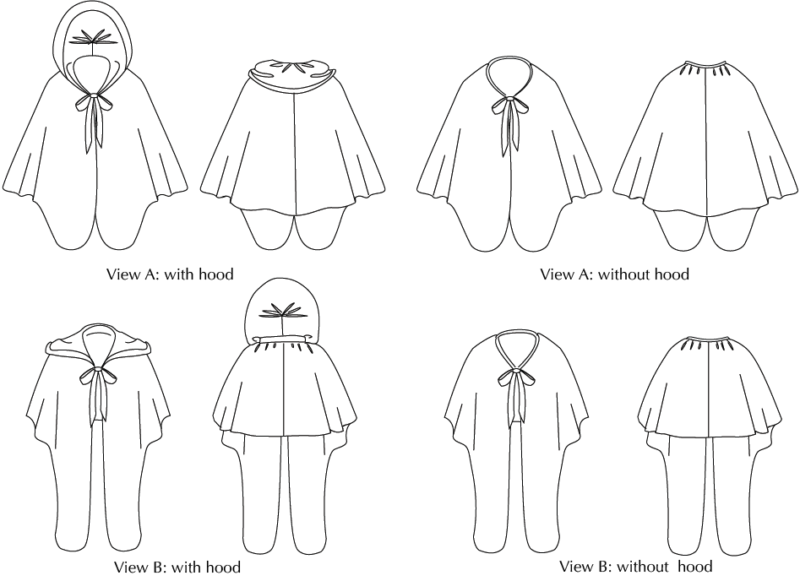
Recommended Fabrics
Outer Fabric: silk taffeta and satin, figured silks. Midweight fulled wools. Sheer cotton for unlined versions, and printed cotton for lined.
Lining: Light-midweight silks including silk satin, lightweight taffetas, and silk lustring/lutestring. Cotton and wool cloaks sometimes had cotton or linen linings or part-linings. If using silk, the outer and lining may be the same fabric.
* Additional piecing is required to fit the pattern pieces on the fabric. See cutting layouts for suggestions.
Consult period images and extant mantles for examples of accurate fabrics and colours.
IMPORTANT: The fabric requirements include the amount needed for mantle’s cut in one piece with no centre back seam and the grainline running along the width of the cloak, and cloaks cut with a centre back seam and the grainline running up and down the cloak. Directional fabrics should be cut with a centre back seam, or otherwise pieced.
Mantles with hoods and without hoods require the same amount of fabric.
Add an additional ¼y/.2m to your fabric requirements for self-fabric trim.
Notions:
- 1½y/1.3m long x ½”/1.2cm-2”/5cm wide silk ribbon for the neck ties
- 100/2 linen or silk hand-sewing thread
- Hoodless mantles: ⅝y/.5m ¼”/3mm wide cotton or linen tape to reinforce the neck
- Optional: 2”/5cm wide silk ribbon for trimming. Trim can also be made from self fabric cut into strips. Add an additional ¼y/.2m to your fabric requirements for trim.
- View A: 9¼y/8.5m ribbon.
- View B: 11¼y/10.3m ribbon
The Sophia Mantle: 1775-1810
The Sophia is a fully lined mantle with two body options featuring squared off lappets that fall to high and mid-calf, an enormous high-fashion hood, and instructions on adding fur, marabou feather, or handmade fringe trim.
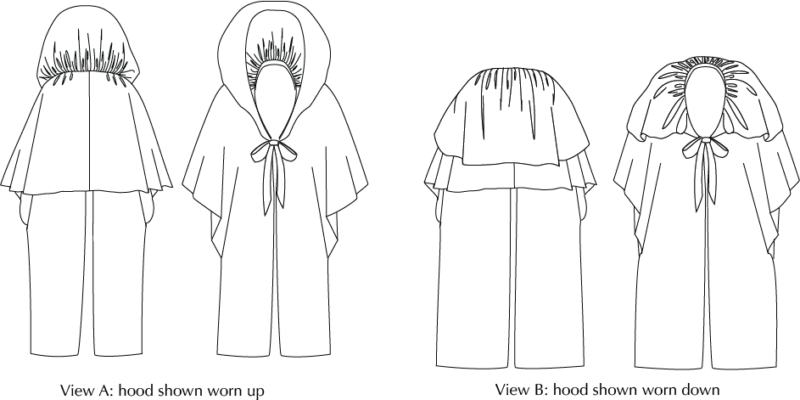
(and yes, this faaaaaabulous mantle is one of the primary inspirations for the Sophia)
Recommended Fabrics
Outer Fabric: silk taffeta and satin, figured silks, velvet and velveteen, fulled wools. Silks & velvets in black, ivory/white, and shades of pink and coral; and wools in black and red are the most common colors seen in extant examples and period images.
Interlining (optional): cotton or wool flannel, very thin wool quilt batting. Polyester quilt batting is NOT recommended as it is too bulky.
Lining: Light-midweight silks including silk satin, lightweight taffetas, and silk lustring/lutestring. The outer and lining may be the same fabric. Some images show mantles with contrasting linings: black or pink/coral mantles with white linings appear to have been most common.
All fabric requirements allow for cutting directional fabric. Extra fabric will be needed for print matching.
* This size and view can be made with ⅝y/.5m less fabric if Piece B is pieced on the corners.
IMPORTANT: Add an additional ¼-½y/.2-.4m for self-made fringe trim.
Notions:
- 1½y/1.3m long x ½”/1.2cm-2”/5cm wide silk ribbon for the neck ties
- 100/2 linen or silk hand-sewing thread
- Trim for neck, hood edge, & lappet ends only: 4y/3.7m fur, marabou feather, or cotton or viscose brush fringe.
- All edges trimmed: 8¼y/7.5m fur, feather or or cotton or viscose brush fringe.
- Self-made silk fringe, neck, hood edge, & lappet ends only: Add an additional ¼y/.2m of fabric per layer of fringing.
- Self-made silk fringe, all edges: Add an additional ½y/.4m of fabric per layer of fringing.
And that’s it! Happy shopping!
We shared some mantle inspiration in our call for testers, but here’s a bit more:
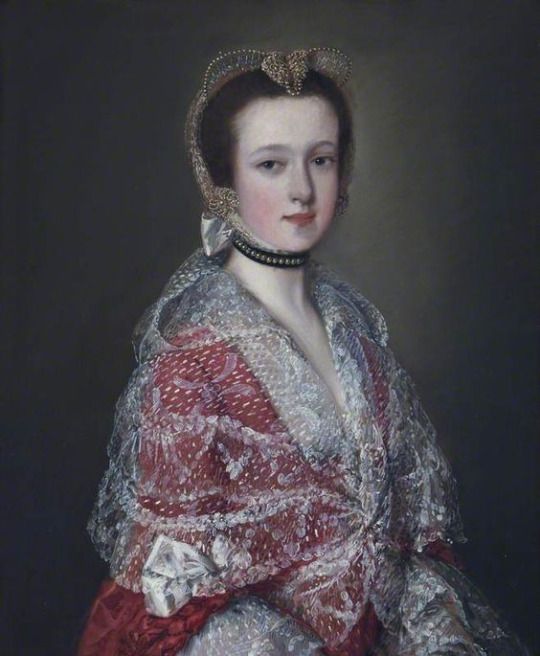
Thomas Gainsborough, portrait of Louisa Barbarina Mansel, Lady Vernon, 1763-7 (c) National Trust, Sudbury Hall; Supplied by The Public Catalogue Foundation



